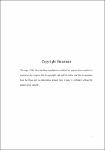Investigating Letter Identification for Visual Acuity Measurements in the Paracentral Visual Field
| dc.contributor.supervisor | Schmidtmann, Gunnar | |
| dc.contributor.author | Barhoom, Hatem | |
| dc.contributor.other | School of Health Professions | en_US |
| dc.date.accessioned | 2023-08-30T13:11:24Z | |
| dc.date.available | 2023-08-30T13:11:24Z | |
| dc.date.issued | 2023 | |
| dc.identifier | 10623873 | en_US |
| dc.identifier.uri | https://pearl.plymouth.ac.uk/handle/10026.1/21271 | |
| dc.description | Publications and conferences posters: Chapter two: - Refereed Conference Publications Barhoom, H., Joshi, M. R., & Schmidtmann, G. (2020). The effect of response biases on resolution thresholds of Sloan letters in central and paracentral vision. The British Congress of Optometry and Vision Science (BCOVS) 2020 (Talk) - Refereed Journal Publications Barhoom, H., Joshi, M. R., & Schmidtmann, G. (2021). The effect of response biases on resolution thresholds of Sloan letters in central and paracentral vision. Vision Research, 187, 110–119. (https://doi.org/10.1016/j.visres.2021.06.002) Chapter three: - Refereed Conference Publications Barhoom, H., Georgeson, M. A., Joshi, M. R., Artes, P. H., Schmidtmann, G. The role of bias, sensitivity and similarity in letter identification task: a noisy template model. AVA 2023 Barhoom, H., Schmidtmann, G., Joshi, M. R., Artes, P. H., & Georgeson, M. A. (2022). The role of similarity and bias in letter acuity measurements: a noisy template model. ECVP 2022 (to be published in Perception) Barhoom, H., Schmidtmann, G., Joshi, M. R., Artes, P. H., & Georgeson, M. A. (2021). The role of bias in a letter acuity identification task: a noisy template model. ECVP 2021 Perception Vol. 50, No. 1 SUPPL, pp. 83-83 - Refereed Journal Publications Georgeson, M. A., Barhoom, H., Joshi, M. R., Artes, P. H., & Schmidtmann, G. (2023). Revealing the influence of bias in a letter acuity identification task: A noisy template model. Vision Research, 208, 108-233 (https://doi.org/10.1016/j.visres.2023.108233). Chapter four: - Refereed Conference Publications Barhoom, H., Artes, P. H., Joshi, M. R., & Schmidtmann, G. (2023). Acuity perimetry with speech input for mapping macular visual field in Glaucoma. The Association for Research in Vision and Ophthalmology (ARVO 2023) (Poster presentation) | en_US |
| dc.description.abstract |
Sloan letters are commonly used optotypes in clinical practice, but they exhibit different relative legibility, which may be attributed to response bias, sensitivity differences, and letter similarity. In this thesis, we employed Luce’s choice model and developed a new noisy template model to investigate the role of response bias, sensitivity differences, and letter similarity in letter identification of Sloan letters at central and paracentral locations. Results show that the best model was the one that accounted for the effects of bias, sensitivity, and similarity, with bias contributing more than sensitivity and similarity. However, when estimating the letter acuity from the pooled data across all letters, no significant effects of bias, sensitivity, or similarity were observed. The models incorporating similarity demonstrated a substantial increase in the spread of the underlying psychometric function (the percent correct as a function of letter size), particularly in the periphery and upper portion of the function. Given that most letter stimuli in clinical vision tests are presented at supra-threshold sizes, it is plausible to attribute any increase in test-retest variability, particularly in peripheral vision, to similarity alone. Furthermore, this thesis explored the use of letters as stimuli and speech as a response method to assess macular visual sensitivity in healthy observers and individuals with 6 Glaucoma. Dissimilar letters following Sloan’s design were used to estimate peripheral letter acuity within 4 degrees of fixation. A speech recognition algorithm was employed to enable participants to perform the task without supervision. The participants’ perceived task difficulty was assessed through a questionnaire. Results from this experiment show that in observers with Glaucoma, letter acuity exhibited a close correlation with conventional perimetry, and most observers found the task easy to perform. These results demonstrate that letter acuity perimetry with speech input is a viable method for capturing macular damage in Glaucoma. These approaches have the potential to facilitate more intuitive and patient-friendly tests for macular visual field assessments. | en_US |
| dc.language.iso | en | |
| dc.publisher | University of Plymouth | |
| dc.rights | CC0 1.0 Universal | * |
| dc.rights.uri | http://creativecommons.org/publicdomain/zero/1.0/ | * |
| dc.subject | paracentral vision | en_US |
| dc.subject | Letter acuity | en_US |
| dc.subject | Home-based test | en_US |
| dc.subject | letter identification Task | en_US |
| dc.subject | Luce's choice model | en_US |
| dc.subject | Noisy Template model | en_US |
| dc.subject | letter similarity | en_US |
| dc.subject | response bias | en_US |
| dc.subject.classification | PhD | en_US |
| dc.title | Investigating Letter Identification for Visual Acuity Measurements in the Paracentral Visual Field | en_US |
| dc.type | Thesis | |
| plymouth.version | publishable | en_US |
| dc.identifier.doi | http://dx.doi.org/10.24382/5092 | |
| dc.identifier.doi | http://dx.doi.org/10.24382/5092 | |
| dc.rights.embargoperiod | No embargo | en_US |
| dc.type.qualification | Doctorate | en_US |
| rioxxterms.version | NA | |
| plymouth.orcid.id | https://orcid.org/0000-0002-3047-3971 | en_US |
Files in this item
This item appears in the following Collection(s)
-
01 Research Theses Main Collection
Research Theses Main



